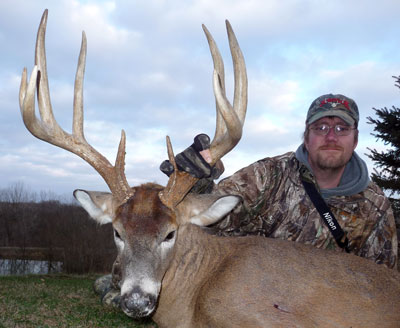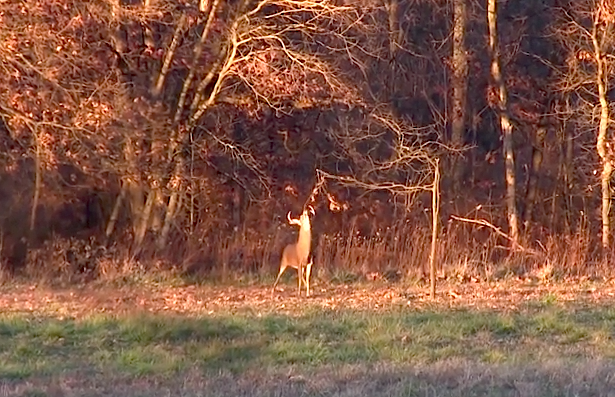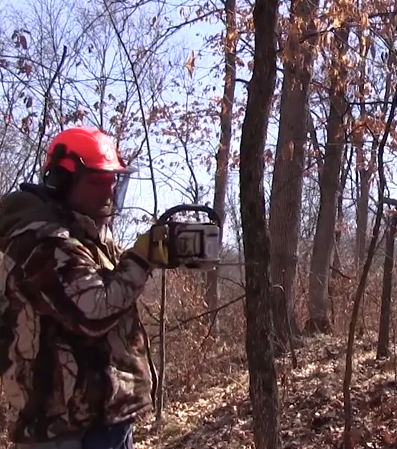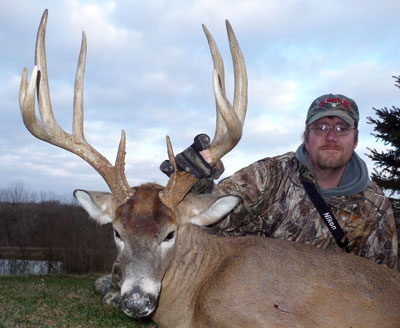
I wasn’t sure if the buck I was after was still alive. He had the strong tendency to bed on my hunting grounds, but also spent a decent amount of time on the other side of the road where the orange army was in full force. With this being the last day of firearms season, I could only hope that all of the time-wasters I’d employed were doing their jobs.
With a half-hour of legal shooting light left, I spotted the Illinois 41⁄2-year-old 9-pointer working the mock scrape I’d created at the opening to the edge feathering along the field. Shifting into kill mode, I got in position for the shot.
When he stopped to feed in the Antler King Trophy Clover, it gave me the chance to study him a bit closer, and I had plenty of time to see the Reconyx pictures had done him justice. He was a solid buck I’d be thrilled to kill. I just needed him to make his way to the honey-hole section of the plot, bringing him to within slug gun range. I was confident the candy crop of brassicas would do just that.
Sure enough, they were too much to resist. As the buck closed ground, I picked a hair in the kill zone and sent a slug on its way. Before finding his way off the plot, the buck piled up. As an added bonus, I was able to catch it all on film for an upcoming episode of D&DH TV.
Reviewing chips from the Reconyx cams a couple of weeks later, I could see how magnificently the time-wasters had done their jobs. I’d caught that buck on three separate cams before I’d spotted him that day, along with a bunch of shots over firearms season. Not only had they led Mr. Big to me, but they’d helped waste his time on my side of the road, minimizing his daylight risks on the other side.
WATCH: Great Tips to Create Better Deer Habitat
STRIKING THE BALANCE
The reasons behind getting bucks to waste time on your ground are easy to grasp. From a hunting standpoint, every daylight second a buck is on your ground is a second you stand a legit chance of killing him. As the old saying goes, “you can’t kill what isn’t there.” Therefore, the more daylight Mr. Big spends on your ground, the higher the odds are of you killing him.
The other reasons involve managing deer. Let me being by emphatically stating that I believe neighbors have the right to legally hunt any way they desire and shoot any legal deer they choose. They shouldn’t be chastised for doing so and you shouldn’t obsess over what’s happening on the other side of the fence.
At the same time, you have those same rights on your side. That includes trying to get another year on some of the younger bucks so you can hunt them next season. You’ll never catch me preaching the passing of young bucks to others. If it’s legal and they tag a buck, more power to them. At the same time, I see it being entirely within my rights to do my best to tilt the odds of the bucks I pass on making it another year.
That’s the other benefit of wasting a buck’s time on your ground. Just like the more time bucks spend on your ground the more your odds of tagging them increase — it also decreases the odds of the neighbor’s tag finding them. Time-wasters can be a big difference maker in getting another year on the bucks, particularly for smaller landowners.
SEE ALSO: THE NEW 2017 DDH WHITETAILS CALENDAR WITH RUT PREDICTIONS
Here’s the catch, though. Going about it the “wrong” way can also make those bucks tougher to kill. For example, if you’re inspiring Mr. Big to waste time in close proximity to his bedding area, you most likely just made him a lot tougher to hunt. You want him to move — making as much of those daylight movements on your ground as you can achieve.
To strike that balance, it’s best to employ the time-wasters in areas where you can hunt. To me, that means I can get to and from this location without spooking deer, as well as hunt it with a safe wind. That doesn’t mean I’ll hunt every area with time-wasters in them, but I have the option of doing so if needed.
By striking that balance, you aren’t encouraging Mr. Big to burn even more time in areas you can’t effectively hunt. Please keep that in mind as you delve into some of the more commonly used and effective time-wasters.

MOCK SCRAPES
When it comes to wasting Mr. Big’s time, mock scrapes are as easy and effective as it gets. Working scrapes typically takes between one-half and as much as five minutes, with a minute probably being close to the average. Heck, bucks often even work the same scrape two or more times within minutes of the last.
A minute doesn’t sound like much of a time-waster, but remember that minutes very often make the difference between Mr. Big showing up during shooting light or as the hunter is climbing out of the tree.
WATCH: How to Make a Mock Scrape to Attract Bucks
To put this in perspective, let’s say the buck you’re after typically gets out of his bed 30 minutes before dark. He wastes five minutes stretching, grooming and relieving himself before heading for the neighbor’s fields. Between browsing, distractions and making his way slowly down his trail, as bucks so often do, we’ll pretend it takes him 20 minutes to reach the property line. That puts him on schedule to jump the fence with five minutes of legal shooting light left, enough for the neighbor to tag this young stud. Sure, that’s purely made up, but it’s not an uncommon scenario.
Now add a series of mock scrapes into the equation. If you can get the buck to work five of them on the way to that fence, he’s standing on your side, watching the neighbor climb out of his stand at dark.
As a bonus, bucks work the licking branches of some of the most heavily used fall scrapes year round as communication hubs. No, they typically don’t paw the ground outside of the rut phases. Instead, they are communicating with other deer via the odors deposited on the licking branches from saliva and various glands on their face and head. During early season, getting Mr. Big to work five licking branches while heading to the neighbors is likely a stretch, but one or two sure isn’t.
Best of all, there isn’t really a complicated formula for laying out where mock scrapes should be. I typically begin by placing potential licking branches at nose level along his path and around food sources, in areas I can safely and effectively hunt.

As you will soon read, I often create his travel corridor with a snake trail food plot, which is a narrow, somewhat winding food plot. On them I like to have one or two licking branches every 10 yards or so.
Most often, these snake trails lead to a staging plot. The staging plot itself will also have one to two licking branches every 10 yards along its edges, as well as a scrape tree “planted” out in the plot for each stand covering it, with the licking branches pointed toward the stand. Along with wasting time, it helps position Mr. Big for the shot and focuses his attention away from the stand.
On the mock scrapes I’ll be hunting, I use Wildlife Research Center’s Magnum Scrape Dripper, filled with Golden Scrape to really draw out the action. For the rest, I merely position licking branches and let the bucks do the rest.
As a final bonus, all of this scraping activity often creates a scraping frenzy. When an area is all scraped up, it’s common for other bucks to start making the area a regular stop of their own, further increasing the amount of time they’re spending on your ground, as well as increasing hunting opportunities.
SNAKE TRAILS
As already mentioned, snake trails are another time-waster I often use. Not only do they help waste bucks’ time, but they also increase the nutrition levels a property offers.

Simply put, snake trails are about 20-yard-wide openings that snake through the woods. I plant them in Antler King’s Trophy Clover on plots with good soils and will be trying out its Game Changer Clover in poorer soils. The draw for me with both products is that they are highly desirable, grow well in less-than-perfect conditions and can withstand heavy feed- ing pressure. Regardless of what you choose to plant, those are the best traits for planting these snake trails.
The openings themselves can be created with large equipment, such as a dozer or backhoe. Though neither is free, you can typically get suitable equipment and a skilled operator for about $100 an hour, and the amount of work they can do in a single day is impressive.
Another alternative is putting a chainsaw to work. Remember, we aren’t cash cropping. Working around stumps isn’t a deal breaker. In fact, if cut high enough, the stumps them- selves can work great for nailing licking branches on the tops with fence post nails.
Next, to further increase effectiveness, edge feather the sides by hinge-cutting the low timber value trees in 10-yard-wide bands. Not only does this open the plot to more sunlight, but the tops create screening to further waste a buck’s time by forcing him to enter the snake plots to see if any does are using it. Edge feathering even increases both the feeling of safety the extra cover provides and creates a surplus of woody browse from the tops that are now within reach.
Snake trails end up wasting time with the slight curves and edge feathering, making the buck weave through the entire trail to check for does or competing bucks, feeding and working scrapes as they go. At the same time, they help dictate movement through areas that can be effectively and safely hunted, as well as dramatically increasing nutrition levels for deer.

STAGING PLOTS
Since snake trails are most effective when covering the last portion of travels from the bedding area to another food source, they work great by connecting travels to larger food sources. However, they can work even better still when connecting to a small staging plot that sits just off that large food source.
Edge-feathered staging plots, ringed with licking branches and planted scrape trees are yet another great time-waster. Because they aren’t meant as primary food sources, 1/3- to 1/2-acre kidney-bean shaped staging plots are sufficient.
Personally, I prefer planting candy crops in staging plots. I consider Antler King’s Honey Hole Brassica mix to be a good choice. To keep these plots going all season, once the brassicas get about 4 inches tall, I top seed them with three parts cereal rye and one part oats, at about 100 pounds per acre. The oats help take feeding pressure off of the brassicas early, with the cereal rye getting hammered after the brassicas have been completely cleaned out.
Just like with the snake trails, the specific plantings should match your conditions. The keys are that the main planting should be a candy crop, with something added that can withstand feeding pressure throughout the season.
CONCLUSION
Now let’s look again at what these three things do for you with that fictitious buck hitting the neighbor’s field right around dark.
When he gets up 30 minutes before dark, he’s still wasting the five minutes around his bedding area. It might take him another 10 minutes to get to the snake trail, where you have a stand waiting for him. Between feeding and working scrapes along that snake trail, he’s going to waste 10 to 15 minutes just to get to your staging plot, giving you a shot there right at the last moment. It’s a pretty safe bet that he’ll burn another 10 minutes feeding and scraping there, before jumping the fence well after shooting light is gone. As a bonus, to get back to his bed on time in the morning, he’ll be back on your side in the staging plot before first light more often than not. That’s when you should be waiting for him farther up the snake trail.
Obviously, it doesn’t always work out that neatly. However, it isn’t that farfetched and illustrates the benefits time-wasters can deliver.
— Longtime Deer & Deer Hunting contributor Steve Bartylla is one of North America’s top deer hunters and private-land deer managers.
+++++
Keep The Bugs Away!
 The latest in Thermacell’s lineup is the Scout Camp Lantern, yet another outstanding product from Thermacell to receive the full endorsement from the Deer & Deer Hunting crew. This lantern pulls double duty as a powerful mosquito repeller utilizing Thermacell’s familiar mat-and-butane combo. Expect 225 square feet of protection from mosquitoes, black flies and more. Get yours here!
The latest in Thermacell’s lineup is the Scout Camp Lantern, yet another outstanding product from Thermacell to receive the full endorsement from the Deer & Deer Hunting crew. This lantern pulls double duty as a powerful mosquito repeller utilizing Thermacell’s familiar mat-and-butane combo. Expect 225 square feet of protection from mosquitoes, black flies and more. Get yours here!

